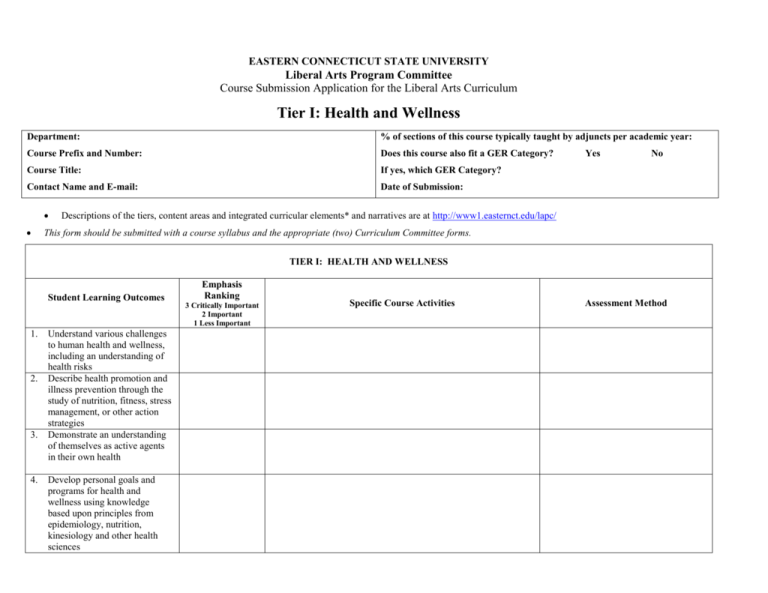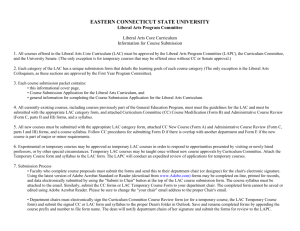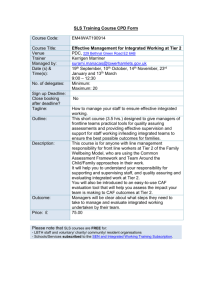Health & Wellness - Eastern Connecticut State University
advertisement

EASTERN CONNECTICUT STATE UNIVERSITY Liberal Arts Program Committee Course Submission Application for the Liberal Arts Curriculum Tier I: Health and Wellness Department: % of sections of this course typically taught by adjuncts per academic year: Course Prefix and Number: Does this course also fit a GER Category? Course Title: If yes, which GER Category? Contact Name and E-mail: Date of Submission: Yes No Descriptions of the tiers, content areas and integrated curricular elements* and narratives are at http://www1.easternct.edu/lapc/ This form should be submitted with a course syllabus and the appropriate (two) Curriculum Committee forms. TIER I: HEALTH AND WELLNESS Student Learning Outcomes 1. 2. 3. 4. Understand various challenges to human health and wellness, including an understanding of health risks Describe health promotion and illness prevention through the study of nutrition, fitness, stress management, or other action strategies Demonstrate an understanding of themselves as active agents in their own health Develop personal goals and programs for health and wellness using knowledge based upon principles from epidemiology, nutrition, kinesiology and other health sciences Emphasis Ranking 3 Critically Important 2 Important 1 Less Important Specific Course Activities Assessment Method Student Learning Outcomes Emphasis Ranking 3 Critically Important 2 Important 1 Less Important Specific Course Activities TIER I: Methods and Concepts (required for all Tier I courses) 1. 2. 3. 4. Recognize and articulate the major concepts and ideas that are foundational to a range of liberal arts disciplines Comprehend the relationships among and distinctions between disciplines and areas of study Understand and employ multiple modes of inquiry and analysis a. Effectively communicate ideas orally:* 4. b. Effectively communicate ideas visually:* 4. c. Effectively communicate ideas in writing:* 5. a. Understand the value of rigorous inquiry and research 5. b. Understand the value of academic integrity 5. c. Understand the value of active engagement in the ECSU learning community and beyond Discern the ethical dimensions of the production and acquisition of knowledge within disciplines* 6. Obtained by cumulative activities of multiple requirements of courses in Tier I Obtained by cumulative activities of multiple requirements of courses in Tier I Obtained by cumulative activities of multiple requirements of courses in Tier I Assessment Method Student Learning Outcomes 7. Ability to think critically* 8. Effectively seek and employ information to achieve academic goals* Emphasis Ranking 3 Critically Important 2 Important 1 Less Important Specific Course Activities Assessment Method Course Submission Application for the Liberal Arts Curriculum General Information The liberal arts curriculum is designed to achieve specific student learning outcomes. Departments propose courses for submission into the Liberal Arts Curriculum to the Curriculum Committee and the Liberal Arts Program Committee. In submitting course proposals, departments are indicating that the syllabus presented is representative of all sections of the proposed course and acknowledge that all syllabi will contain the LAC tier and category student learning outcomes and other requisite components of a LAC syllabus. Departments will insure that the objectives of the LAC will be declared and taught in all sections of the proposed course. This is not to impede academic freedom. The LAPC recognizes that there are multiple methods to achieve the student outcomes. The diversity of approaches to achieve these ends promotes creativity and enriches the curriculum. Outcomes These student learning outcomes are identified as the learning outcome for a particular tier of the liberal arts curriculum and for the specific category of the tier. All courses accepted for inclusion within the Liberal Arts Curriculum must develop the student learning outcomes for each of the outcomes for the categories and contribute to the development of learning outcomes for the tier and for the entire curriculum. Emphasis Ranking Identify your intention and active effort to assist students to achieve each of the goals. All outcomes are not equally addressed in every course. The value placed on the outcomes may be evidenced by the time, grade weight or other factors. Ranking of your emphasis assists the LAPC in understanding the focus of the course and how all courses within LAC tiers contribute to student learning. Emphasis Ranking: 3 This outcome is critically important to the course and will be strongly emphasized 2 This outcome is important to the course and will receive some emphasis 1 This outcome is less important to the course and will be addressed but not emphasized NA If there is a compelling reason based on the nature of the course that precludes meeting one of these requirements, please insert the rationale in the specific course activities box. Specific Course Activities How will the instructor insure that the learning objectives are met? Please provide specific course activities designed to achieve student outcomes in each area. Your syllabus will illustrate the overall requirements and content of your course. Please highlight specific teaching approaches, student activities, resources employed, reading assignments or other strategies to produce these learning outcomes. Active learning activities are encouraged to promote student engagement and learning at higher levels. These may include: debates, presentations, student team reports, demonstrations, experiments, discussion, problem-solving, assessing, designing, role playing, simulation and other activities. Assessment Methods How will the instructor evaluate whether students in the class achieve these outcomes and at what level of achievement? How will the instructor evaluate whether the course achieved the expectations for overall student learning of these objectives? If available, attach copies of assessment tools to your submission. There are a variety of sources of evidence of student achievement of goals. These may include: Embedded assessments such as papers, exams, projects, lab reports, presentations, journals Methods to communicate assessment such as rubrics, comments, grade reports, feedback mechanisms Student self-evaluation tools Syllabus Course syllabi for the Liberal Arts Curriculum (LAC) must include 1) the learning outcomes for the appropriate tier and category of the LAC; 2) show evidence of how specific tier outcomes will be assessed in the course by providing a brief description of the key assignments/exams/performances/etc. Curriculum Committee Forms All courses submitted for the LACC for the first time will be treated as new courses to be approved by the Curriculum Committee.







